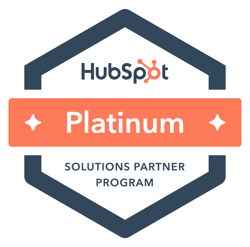This post was updated on September 15th, 2020
We all love measuring our results and every team will have a set of event marketing KPIs that they live and die by. If you’re still measuring your activities the old way and moving towards marketing the new inbound way, you’re not going to have the info you need to make smart decisions.
By the way, we have decided to refer to a virtual, hybrid or physical event just as "events", while there are defined differences in the delivery and format of each, they way you approach their marketing is generally the same.
So, what event marketing KPIs does the modern inbound marketer use? You may be relieved to hear that there are only 3 core measurements, although each can be scrutinised further to reveal more information to inform your tactics. We’ve also included some additional metrics that you’ll use to further boost your performance.
1. Number of visits to event site/microsite.
Why measure it:
This is the basic and obvious indicator of the level of awareness your market has about your business/product/event. It gives you the insight into the top end of your inbound marketing funnel.
How to do it:
- SEO - use smart SEO tactics to get found by people searching for what you offer.
- Blogs & remarkable content - give people a reason to visit your event page, once you have them there you have more time and real estate to get them interested in your event (and remarkable content will do just that).
- Social media - if you can go beyond using social media as a broadcast channel and engage influencers who’ll talk about your event your traffic will soar.
- Media partners - don’t just accept a banner and walk away, get creative and collaborative on your traffic driving efforts (start by using your content as a lure and go from there).
- Sponsor marketing - it’s in their interest to let as many hot prospects as possible know about your event, through their own marketing channels.
These all have a role to play in raising that initial awareness amongst strangers and increasing your event website visits.
“Knowledge is power” tip:
Go deeper and break down the sources of your visits to uncover the most successful tactics, then compare new vs. returning to get an idea of if you’re doing a good job of engaging the visitors before they turn into leads.
Bonus metrics:
Measuring your visit-to-lead and visit-to-customer ratios will provide you with further context for your campaign. Looking at how many visits you need to create one lead or per customer gives you an idea of the level of effort that your current campaign is going to require to hit target. It’s also a way of measuring the effectiveness of any changes you make to your lead generation and lead nurturing processes, because if these ratios come down you know you’re converting more effectively and it’ll take less up front grunt to get to target.
2. Leads
Why measure it:
Making your market aware of your event is only a third of the battle. You then need to get them interested enough to become engaged leads, either by enquiring, engaging regularly with your content and/or agreeing to hear from you on a more personal basis (email/phone).
How to do it:
- Specific landing pages - have a single call to action on each landing page and you’ll seriously boost your lead volumes. Don’t make people choose what to do, give them one thing you ask for and stick to it. Want something else? Different communication, different landing page.
- Special offers – an offer is only interesting if you have half a notion you might want to the product on offer, so special offers are a good way of sorting your leads and pulling the best, most qualified ones to the surface.
- Lead nurturing emails – just because someone clicked on an email or read an article, doesn’t make them a prime candidate for the event. You need to build that relationship, increasing trust by delivering extra value in your emails.
- Content, content, content - that’s the good stuff like guides, e-books and other stuff people see enough value in to download.
We have more on effective lead generation for events elsewhere on the blog.
“Knowledge is power” tip:
Don’t just count your leads, grade them too. Someone who’s actively enquired about attending the event is worth more to you than someone who’s just downloaded one piece of content. Being able to see the quality as well as the number of leads is a distinct advantage.
Bonus metrics:
Your lead-to-customer ratio gives you a focussed look at how effective your lead nurturing techniques are. Bringing down the number of leads you need to make a sale is one of the most effective uses of your time and effort when it comes to event marketing.
3. Revenue
Why measure it:
Hmm, this one hardly needs explaining does it? We all like to know we’re making money! But aside from making you smile, this metric indicates your conversion power; how good you are at turning leads into customers.
How to do it:
- Website sales/e-commerce – make your event site super sticky and conversion friendly.
- Telesales – work collaboratively with sales so they’re not just cold calling huge lists, but rather picking from the best qualified leads and understanding the history with the prospect before they call.
“Knowledge is power” tip:
Match revenue back against lead source and type to inform your lead grading and where possible against visitor source to gain extra insight into what works best.
Bonus metrics:
Revenue isn’t the be all and end all (“what about marketing ROI?” I hear you cry!). A relative of marketing ROI that’s more helpful for inbound marketing measurement is CPA (cost-per-acquisition). This is the total amount of money you had to spend to get the sale or lead – not just from marketing but sales/research/telemarketing etc. too. It’s a more accurate measure of success and reducing your CPA definitely makes your event more profitable, whereas great marketing ROI means nothing if your sales or database research costs are enormous.
What tools do I need to measure these KPIs?
Your basic toolkit and analytics service e.g. Google Analytics (free) and a CRM or marketing automation software (there’s some great low cost and free marketing automation software out there so don’t cry budget on this one!). In addition, you’ll need access to your internal bookings system.
You’ll notice that our event marketing KPIs are pretty simple. And with good reason. We don’t want you spending so long measuring and analysing that you run out of time to do any marketing. But what gets measured gets done, so measuring the things that really matter will keep you focused on the stuff that’ll make the biggest difference to your overall event result.








Do you have any comments?